by Dave Senf
April 2021
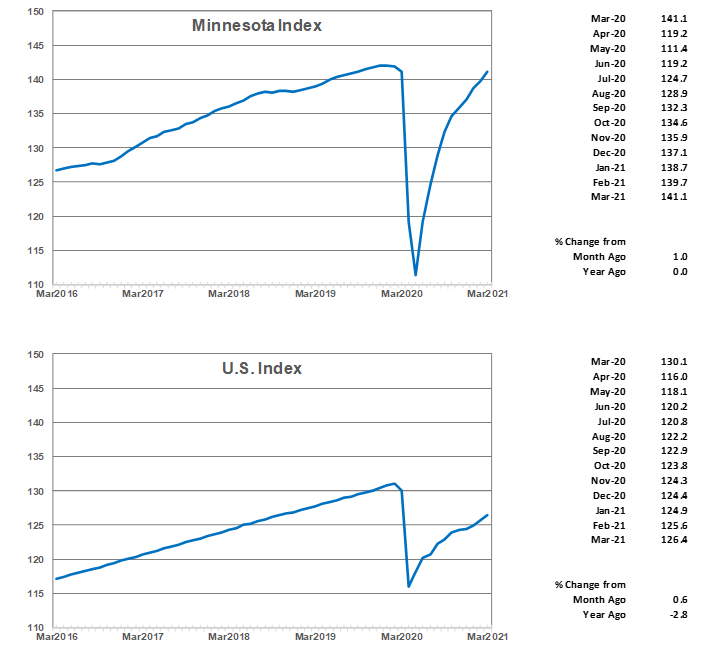
The Minnesota Index rose for the 10th straight month in March, advancing 1.0%. The easing of business restrictions, expanding vaccination rate, and additional federal COVID-19 relief are helping to fuel Minnesota economic growth. The U.S. Index increased 0.6% as the monthly increase in the Minnesota Index outpace the U.S. Index for the 10th consecutive month.
The coincident indices combine four state-level indicators to summarize current economic conditions in a single statistic which is sort of a proxy for monthly GDP. The four state-level variables in each coincident index are nonfarm payroll employment, average hours worked in manufacturing by production workers, the unemployment rate, and wage and salary disbursements deflated by the consumer price index.
Minnesota's advance in March was powered by positive changes in all four components. Wage and salary employment (nonfarm payroll employment), average weekly manufacturing hours, and real wage and salary disbursements all increased. Minnesota's unemployment rate dropped from 4.4% in February to 4.2% in March. The fall off was the 10th straight month that the rate has decreased after reaching a 45-year record-high of 11.3 last May. Much of the improving unemployment rate however is from individuals leaving the labor force rather than securing employment. Employees are having a hard time hiring right now which is slowing Minnesota's economic rebound. Workers on the sideline are expected to reenter the workforce as the job market improves and COVID-19 health concerns tail off.
March's index for the state matched last March's level compared to the U.S. index which was 2.8% below a year ago. The Minnesota Index is 0.6% below its all-time high recorded last December while the U.S. Index is 3.6% below its all-time high set in February this year. Based on state coincident indices (which is what the Minnesota Index is) 10 states recorded their all-time high index reading in March implying that state GDP has recovered completely from the plunge last April. Minnesota is between Ohio and Oklahoma in March with the smallest shortfall of all-time high. West Virginia, Hawaii, Washington, Nevada, and Connecticut all had indices that were 10% or more below their all-time index high. South Dakota is one of the states with a GDP greater than before the pandemic recession while the indices for Iowa (1.1% below), Wisconsin (1.2% below), and North Dakota (5.8% below) remain under all-time highs.
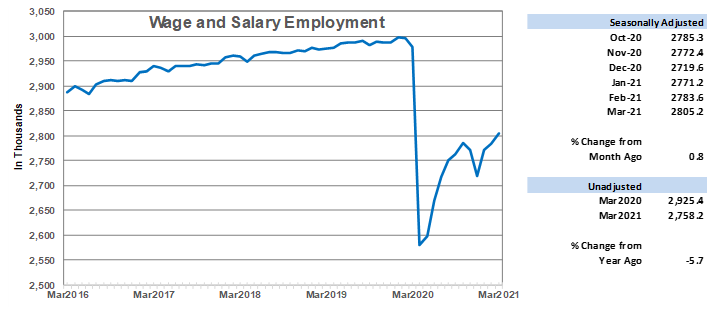
Wage and Salary Employment climbed for the third straight month in March with employment climbing by 21,600 jobs. The 0.8% monthly job gain in Minnesota was a bit higher than the U.S. 0.6% gain. Minnesota's job growth has outpaced U.S. job growth for the first three month of the year as Minnesota employment has increased 3.1% since the start of the year while U.S. employment is up 1.1% through the first three months. Minnesota's businesses have been busy reopening and hiring since 2021 began. March's job gain translates into Minnesota's having recovered roughly 54% of the 4,169,000 jobs lost during the pandemic as of this March. Nationally 62% of the 22.4 million jobs lost across the nation last March and April have been recovered as of March.
Private sector employers added 23,000 workers while public sector payrolls were cut by 1,700. Most of the hiring occurred in Construction, Professional and Business Services, Leisure and Hospitality, Trade, Transportation and Utilities, and Manufacturing. Construction payrolls jumped by 7,900, bouncing back from a 5,400 cutback in February when the cold snap hampered construction activity.
March's unadjusted over-the-year change was -5.7% compared to the national -4.4%. Seasonally adjusted unemployment dipped to 4.2% in Minnesota in March while the U.S. unemployment rate dipped to 6.0%. The labor force in Minnesota in March was down 3.0% from last February with labor force participation slipping 2.4 percentage points. The U.S. labor force over the same period was down 2.4% with the labor force participation rate decreasing 1.9 percentage points. Over the last 50 years Minnesota's labor force participation rate has on average run 6.9 percentage points higher than the nation rate. March's Minnesota rate was 67.8% compared to the 61.5% U.S. rate, a 6.3 percentage point differences.
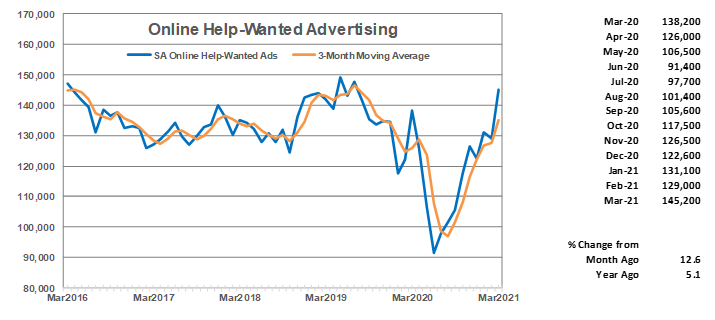
Online Help-Wanted Ads reversed directions in March, climbing 12.6% to 145,000. That was the highest level since July 2019. U.S. online job postings climbed 10.3%, reaching an all-time high. Minnesota's all-time high was set in March 2019 at 149,000. Online help-wanted ads are considered a proxy for labor demand, suggesting that hiring in Minnesota and across the country will continue to be robust over the next few months. Minnesota's share of U.S. online job listings remained at to 2.3% in March which is slightly higher than the 2.0% share for U.S. nonfarm employment accounted for by Minnesota in March.
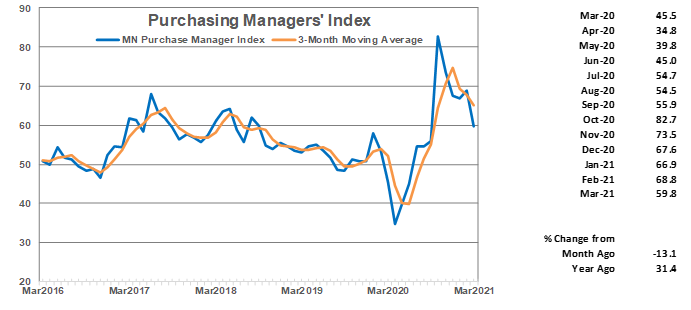
Minnesota's Purchasing Managers' Index (PMI) reported an unexpected decline in March to 59.8. This was the lowest reading since last September. The reading is above the growth-neutral 50 suggesting that manufacturing activity in the state is still expanding at a steady rate but has downshifted a gear or two from the last few months. The PMI index hints at the direction of manufacturing activity trends. A reading above 50 indicates that Minnesota manufacturers expect manufacturing activity to expand, while a sub-50 reading suggest contracting production over the next few months.
The national ISM Manufacturing Index jumped to a very strong 64.7 while the Mid-America Business Index (nine states including Minnesota) slipped slightly to 68.9. Minnesota's lower reading implies that the state manufacturers aren't as optimistic about the speed of manufacturing expansion in the state as manufacturers are across other parts of the nation.
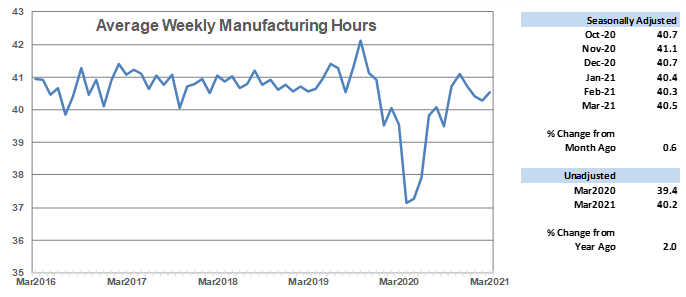
After stumbling for three consecutive months, average weekly Manufacturing Hours inched up to 40.5 hours. March's increase is consistent with Minnesota's manufacturers continuing to expand by adding overtime. The sector also added workers in March, hiring 1,900 new employees. Manufacturing payrolls contracted by 21,500 last March and April, and employment has bounced back by 7,900 jobs or 37% of jobs lost, through March. Durable goods manufacturing has recapture 14% of jobs lost while nondurable goods manufacturing has recovered 70% of jobs lost. Manufacturing employment nationally has recovered 63% of the 1.4 million pandemic-induced national employment decline. Durable goods manufacturing has recovered 59% of jobs lost, while nondurable manufacturing has recovered 71%.
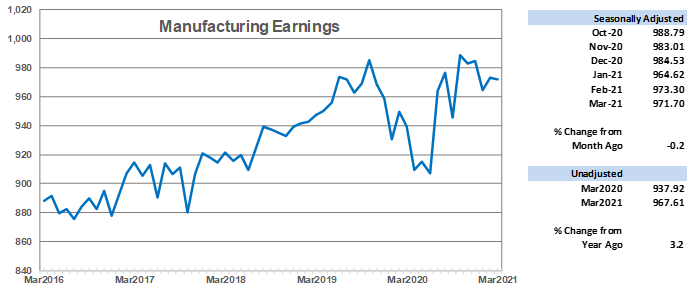
Seasonally adjusted average weekly Manufacturing Earnings, adjusted for inflation, zigzagged up slightly in March, moving to $971.70. Fatter factory paychecks are consistent with increased factory hours and with reports of manufacturers in the state having a hard time finding qualified workers. Unadjusted factory paychecks were up 3.2% from last year in real terms. On a year-over-year basis real manufacturing earnings increased on average by 2.3% after having dipped on average 2.8% over the previous six months. The rise in over-the-year pay may in part be caused by the hard time manufacturers are having finding new hires.

Adjusted Residential Building Permits, a proxy for future home building construction, bounced back in March to 3,254. That is the highest monthly total since August 2018. The home-building market remains solid with the supply of homes on the market remaining near record lows while home demand is boosted by relatively low mortgage rates and an expanding number of millennials looking to buy their first house. Home-building permits in Minnesota in March accounted for 2.0% of U.S. permits or slightly more than Minnesota's population share. Permit levels over the first three months of the year are up 57% from a last year, a good harbinger that 2021 will be a blockbuster year for home building in Minnesota.